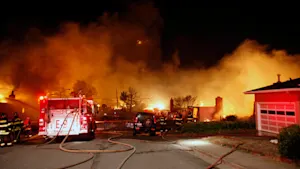FEMA revamps flood insurance risk assessment; national flood insurance rates could skyrocket
Homeowners across New Jersey who carry national flood insurance could see rates skyrocket as the Federal Emergency Management Agency revamps its risk assessment following a summer of devastating floods.
•
Oct 4, 2021, 12:45 PM
•
Updated 1,425 days ago
Share:
More Stories
1:31

What's Cooking: Uncle Giuseppe's Marketplace's prime rib roast
247ds ago1:30

Looking for a road trip? Check out Big Snow at American Dream in East Rutherford
443ds ago1:27

What's Cooking: Uncle Giuseppe's quiche lorraine
479ds ago2:34

Guide: Safety tips to help prevent home burglaries
543ds ago2:19

Guide: Safety measures to help prevent fires and how to escape one
691ds ago2:36

Looking for a road trip? Check out Trap Door Escape Room in Red Bank
716ds ago1:31

What's Cooking: Uncle Giuseppe's Marketplace's prime rib roast
247ds ago1:30

Looking for a road trip? Check out Big Snow at American Dream in East Rutherford
443ds ago1:27

What's Cooking: Uncle Giuseppe's quiche lorraine
479ds ago2:34

Guide: Safety tips to help prevent home burglaries
543ds ago2:19

Guide: Safety measures to help prevent fires and how to escape one
691ds ago2:36

Looking for a road trip? Check out Trap Door Escape Room in Red Bank
716ds agoHomeowners across
New Jersey who carry national flood insurance could see rates skyrocket as the Federal
Emergency Management Agency revamps its risk assessment following a summer of devastating floods.
Sen. Bob
Menendez wants a pause in this new risk
rating program before it takes effect in April on existing policy
holders.
A new flood
risk rating rolled out by FEMA at the start of the month on new policies is set to
impact existing National Flood Insurance
Program holders next spring.
“What I say about FEMA 2.0 is that it’s one step forward, four steps back,”
says Amanda Devecka-Rinear, executive director of New Jersey Organizing Project. “The one good thing about it is
the more accurate flood mapping. But the real challenge is there aren’t
affordable guarantees in this program."
Devecka-Rinear
runs the New Jersey Organizing Project made up of Superstorm Sandy survivors.
They take on issues specific to the needs of people who lived through
disasters in New Jersey. She supports Menendez and the bipartisan
effort from other lawmakers in vulnerable states calling for a halt of the
rollout.
“The only decent thing to do is to put a pause
before that April 1st implementation
to really have meetings,” says Devecka-Rinear. “How it will impact the
community – explain what’s happening and also hear from policy
holders to hear what changes they want to see. “
FEMA says the new risk system incorporates more
flood risk variables such as frequency, flood types, storm surge and
heavy rainfall.
“The idea of flood insurance only being storm surge,
only coming from the ocean, bay, or river or whatever else it is, it’s a lot
more about groundwater accumulation, rapid rain,” says Chris San Filippo, with Farmers Insurance.
FEMA says most policy holders will see a decrease in rates under the new system and some will see increases, but annual rates could increase by
18%.
The worry is the increases could price people out
of their homes.
Menendez says 80% of New Jersey policy
holders would see their premiums increase under
the new risk rating and that hundreds would face
annual rate hikes of more than $1,000.
More from News 12

Drawbridge malfunction snarls service on North Jersey Coast Line
0:26

Man accused of stalking, sexually extorting New Jersey woman and sharing child pornography
2:18

Sunny and cool start to the Labor Day Weekend in New Jersey
0:38

Jersey Proud: Backpack drive held in Evesham for students
0:13

Car crashes through wall of Bridgewater Township home
1:56
